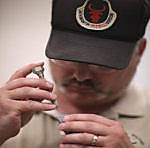Quoted Text
really looks good, I will have to try the pastels in water suspension to see how it comes out...I mainly use dry pastels and then overcoat with clear flat. Any technique hints?
Well, lets see...
Using this technique, I can go straight to weathering without having to seal the model in gloss or dull coats. I use Tamiya Acrylics, and let them dry overnight before applying this technique - only because I don't have a lot of time to sit at my workbench anymore. You could move a little faster.
The water doesn't hurt the dried Tamiya Acrylics - so no need to protect the paint job.
I use a little plastic Shot Glass to hold my water - that's all the water you'll need to do the entire T-55 model. It is very easy to control the amount of "deposit" you want to leave on the model by varying the amount of water you're using with the pastels. I scrape the colors I want to use into a little plastic cap or tub and then add water until the consistency is something like mud.
From here, I like the use a #1 flat point brush to apply the mixture. I dip the brush into the pastel sludge, and then dip the whole brush into the water, before applying it to the model. It always looks a lot messier than it will dry, so don't be afraid of it. The water will carry it into the nooks and crannies, depositing the pastels as it evaporates.
There is NO odor when doing this too - which is great. Also, when dry - they stay put - no need to overspray unless you're handing the model a lot.
Varying the colors of pastels you use will change the tones you get when the area dries. I like to mix up a large batch of the basic color I'm using - unless I'm going for a "patchwork" appearance.
I like using the pastels because of the range of colors and textures you can acheive and keep a scale appearance. This is an easy way to apply them.
Gunnie







































